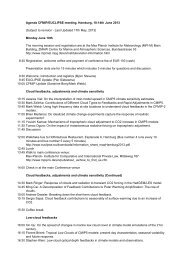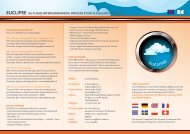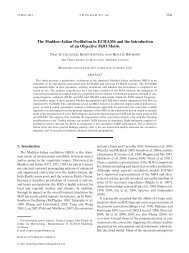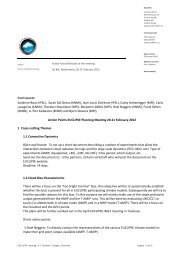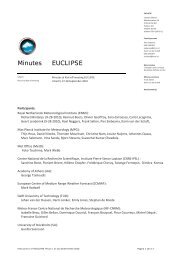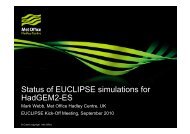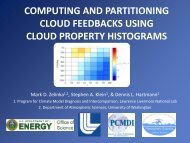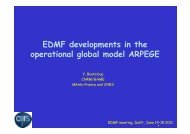EUCLIPSE First Period Report
EUCLIPSE First Period Report
EUCLIPSE First Period Report
Create successful ePaper yourself
Turn your PDF publications into a flip-book with our unique Google optimized e-Paper software.
perturbed future climate conditions are enforced by increasing the SST by 2K and by<br />
weakening the subsidence.<br />
Figure 6. Schematic of the stratocumulus to cumulus transitions as observed<br />
during the <strong>First</strong> Lagrangian of ASTEX. Five aircraft flights were performed<br />
between 12-14 June 1992.<br />
a. Set up of the ASTEX transition case<br />
For a model intercomparison case the time-dependent large-scale divergence rate, the<br />
sea surface temperature (SST), and the geostrophic wind components need to be<br />
prescribed. Because a Lagrangian trajectory is modelled the horizontal advection<br />
terms can be neglected.<br />
The SST is taken from Bretherton et al. (1999), who provide a best estimate of the<br />
time-varying SST along the ASTEX <strong>First</strong> Lagrangian trajectory on the basis of ECWMF<br />
SST fields that were obtained with a data assimilation procedure, direct<br />
measurements from the ship R/V Oceanus and radiometric observations from aircraft.<br />
In the subtropical parts over the oceans, the large-scale divergence of the horizontal<br />
winds is characterized by positive values in the lower part of the atmosphere, which is<br />
associated with a large-scale descending motion, which is often referred to as largescale<br />
subsidence. For the ASTEX area, there is a considerable uncertainty not only in<br />
the magnitude but also in the sign of the large-scale divergence. Bretherton et al.<br />
analysed ERA-40 data and found that the large-scale divergence in the column<br />
changed sign after approximately 15 hours (see Figure 7). By contrast, Ciesielski et<br />
al. (1999) calculated the large-scale divergence directly from radiosonde observations<br />
and found no change in the sign. Sigg and Svensson (2004) applied a spectral<br />
23



